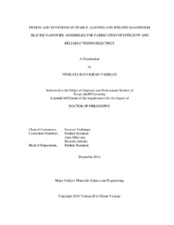| dc.contributor.advisor | Vaddiraju, Sreeram | |
| dc.creator | Vasiraju, Venkata Ravi Kiran | |
| dc.date.accessioned | 2017-03-02T16:48:45Z | |
| dc.date.available | 2018-12-01T07:21:38Z | |
| dc.date.created | 2016-12 | |
| dc.date.issued | 2016-12-09 | |
| dc.date.submitted | December 2016 | |
| dc.identifier.uri | https://hdl.handle.net/1969.1/159042 | |
| dc.description.abstract | The ever-increasing energy needs of humanity, coupled with geopolitics of fossil fuels, are imposing demand on the energy supply. A perennial supply of energy is possible by tapping into renewable sources as well as making the current process more efficient. This can be achieved via the use of thermoelectrics, i.e. they can be used to generate energy by converting sunlight into electricity via solar thermoelectrics and increase the efficiency of current processes by converting the wasted heat into electricity. However, the current state-of-the-art thermoelectrics are inefficient and expensive due to the use of rare earth materials.
Nanomaterials, especially nanowires, are on the forefront of advancement in thermoelectrics. Recent theoretical and experimental reports indicate the superior energy conversion performances of nanowires compared to their bulk counter parts. However, this superior performance is only observed in single-nanowire devices. Despite more than two decades of research, macro-devices based on large-scale nanowire assemblies, have not been realized. The three main roadblocks for fabricating such large-scale assemblies are lack of 1) methods for mass producing nanowires of any desired chemical composition, 2) techniques for assembling these nanowires into energy conversion devices in an interface engineered manner, and 3) techniques to stabilize the nanowires at higher temperatures against air- water- and acid-assisted degradation. In this context, the objective of this work is to design a strategy to obtain stable and efficient nanowire-based thermoelectric devices. The material systems chosen for this effort are Zinc Phosphide Zn3P2, Magnesium Silicide, Mg2Si, and Manganese Silicide MnSi1.75.
Methods for mass production of Zn3P2 and Mg2Si nanowires have been realized previously via a combination of chemical vapor deposition, electroless etching and solid-state diffusion. The assembly and aligning of nanowires was achieved using shear forces via Equal Channel Angular Extrusion (a severe plastic deformation technique). Assembly of the nanowires was also achieved via welding of nanowires utilizing the solid-state diffusion. The nanowires were chemically stabilized by nonconformally decorating them with boron nitride. The stabilization and welding of nanowires helped to achieve decreased thermal conductivity thereby improving their thermoelectric performance compared to the as-obtained nanowire pellets. | en |
| dc.format.mimetype | application/pdf | |
| dc.language.iso | en | |
| dc.subject | nanowire | en |
| dc.subject | thermoelectric | en |
| dc.subject | non-conformal decoration | en |
| dc.subject | welding | en |
| dc.title | Design and Synthesis of Stable, Aligned and Welded Magnesium Silicide Nanowire Assemblies for Fabrication of Efficient and Reliable Thermoelectrics | en |
| dc.type | Thesis | en |
| thesis.degree.department | Materials Science and Engineering | en |
| thesis.degree.discipline | Materials Science and Engineering | en |
| thesis.degree.grantor | Texas A & M University | en |
| thesis.degree.name | Doctor of Philosophy | en |
| thesis.degree.level | Doctoral | en |
| dc.contributor.committeeMember | Karaman, Ibrahim | |
| dc.contributor.committeeMember | Srinivasa, Arun | |
| dc.contributor.committeeMember | Akbulut, Mustafa | |
| dc.type.material | text | en |
| dc.date.updated | 2017-03-02T16:48:45Z | |
| local.embargo.terms | 2018-12-01 | |
| local.etdauthor.orcid | 0000-0003-4269-0735 | |


